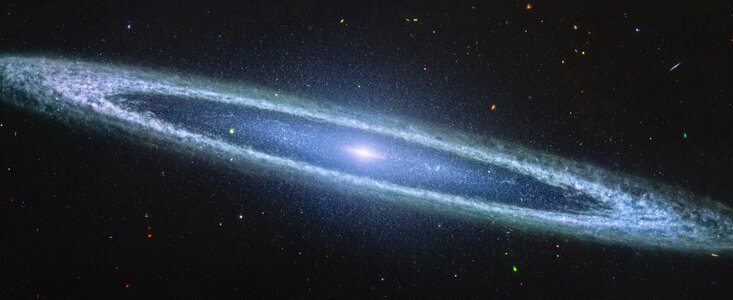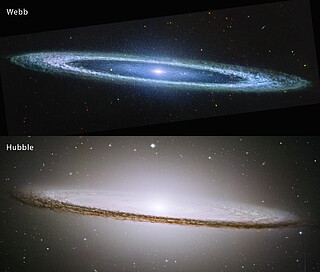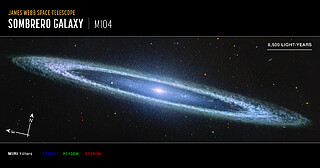weic2427 — Photo Release
Sombrero Galaxy dazzles in new Webb image
25 November 2024
A new mid-infrared image from the NASA/ESA/CSA James Webb Space Telescope features the Sombrero galaxy, also known as Messier 104 (M104). The signature, glowing core seen in visible-light images does not shine, and instead a smooth inner disk is revealed. The sharp resolution of Webb’s MIRI (Mid-Infrared Instrument) also brings into focus details of the galaxy’s outer ring, providing insights into how the dust, an essential building block for astronomical objects in the Universe, is distributed. The galaxy’s outer ring shows intricate clumps in the infrared for the first time.
Researchers say the clumpy nature of the dust, where MIRI detects carbon-containing molecules called polycyclic aromatic hydrocarbons, can indicate the presence of young star-forming regions. However, unlike some galaxies studied with Webb, including Messier 82, where 10 times as many stars are born as in the Milky Way galaxy, the Sombrero galaxy is not a particular hotbed of star formation. The rings of the Sombrero galaxy produce less than one solar mass of stars per year, in comparison to the Milky Way’s roughly two solar masses a year.
The supermassive black hole at the centre of the Sombrero galaxy, also known as an active galactic nucleus (AGN), is rather docile, even at a hefty 9-billion-solar masses. It’s classified as a low luminosity AGN, slowly snacking on infalling material from the galaxy, while sending off a bright, relatively small, jet.
Also within the Sombrero galaxy dwell some 2000 globular clusters, a collection of hundreds of thousands of old stars held together by gravity. This type of system serves as a pseudo laboratory for astronomers to study stars – thousands of stars within one system with the same age, but varying masses and other properties is an intriguing opportunity for comparison studies.
In the MIRI image, galaxies of varying shapes and colours litter the background of space. The different colours of these background galaxies can tell astronomers about their properties, including how far away they are.
The Sombrero galaxy is around 30 million light-years from Earth in the constellation Virgo.
Stunning images like this, and an array of discoveries in the study of exoplanets, galaxies through time, star formation, and our own Solar System, are still just the beginning. Recently, scientists from all over the world converged—virtually—to apply for observation time with Webb during its fourth year of science operations, which begins in July 2025.
General Observer time with Webb is more competitive than ever. A record-breaking 2377 proposals were submitted by the 15 October 2024 deadline, requesting about 78,000 hours of observation time. This is an oversubscription rate, the ratio defining the observation hours requested versus the actual time available in one year of Webb’s operations, of around 9 to 1.
The proposals cover a wide array of science topics, with distant galaxies being among the most requested observation time, followed by exoplanet atmospheres, stars and stellar population, then exoplanet systems.
More information
Webb is the largest, most powerful telescope ever launched into space. Under an international collaboration agreement, ESA provided the telescope’s launch service, using the Ariane 5 launch vehicle. Working with partners, ESA was responsible for the development and qualification of Ariane 5 adaptations for the Webb mission and for the procurement of the launch service by Arianespace. ESA also provided the workhorse spectrograph NIRSpec and 50% of the mid-infrared instrument MIRI, which was designed and built by a consortium of nationally funded European Institutes (The MIRI European Consortium) in partnership with JPL and the University of Arizona.
Webb is an international partnership between NASA, ESA and the Canadian Space Agency (CSA).
Image Credit: NASA, ESA, CSA, STScI
Links
Contacts
Bethany Downer
ESA/Webb Chief Science Communications Officer
Email: [email protected]
Ninja Menning
ESA Newsroom and Media Relations Office
Email: [email protected]
About the Release
| Release No.: | weic2427 | |
|---|---|---|









